Credit Union vs. Retail Bank Mortgage and Interest Rates
When looking to fulfill your banking needs, like opening a savings account or taking out a mortgage, it makes sense to initially turn to a bank. But there’s another option that may come with unique benefits and better interest rates -- a credit union.
Credit unions offer most of the same services a bank does. The key differences between the two are that credit unions are nonprofit organizations owned by their member customers while banks are for-profit and can be private or public companies.
In the past year, on average, credit unions have offered better mortgage rates, auto loan rates, checking account interest rates, savings account interest rates, home equity line of credit rates, and five-year certificates of deposit rates than banks.
In some areas, the difference in rates between credit unions and banks may seem marginal, but even the smallest difference can add up over years.
Key findings
- In the second quarter of 2021, credit unions provided better interest rates than banks for mortgages, auto loans, 5-year CDs, checking accounts, savings accounts, and home equity lines of credit.
- Credit unions, on average, also provided better interest rates than banks in those categories over the past four years.
- Over the past decade, banks have offered better interest rates than credit unions in two categories: 30-year and 15-year fixed-rate mortgages.
Credit union vs. retail bank mortgage rates
Credit unions have offered better interest rates over the past year (2020–21) in three major mortgage categories: 30-year fixed-rate mortgages, 15-year fixed-rate mortgages, and 5/1-year adjustable-rate mortgages.
It’s no surprise, then, that Navy Federal Credit Union is among the best mortgage lenders recommended by The Ascent.
Even though credit union mortgage rates are, on average, only a fraction of a percentage point lower than what banks offer, a slightly lower rate translates into a smaller monthly payment that can add up to big savings over the lifetime of a mortgage.
While shopping for a home loan, it’s important to keep in mind that there are a slew of other costs associated with buying a home to consider, like a down payment, closing costs, maintenance, and property taxes.
Credit union vs. retail bank 30-year fixed-rate mortgage rates
In the second quarter of 2021, the national average 30-year fixed-rate mortgage interest rate provided by credit unions was 3.14%. The national average rate that banks provided was 3.15%.
Over the past year, credit unions provided lower rates than banks for 30-year fixed-rate mortgages in three out of four quarters.
However, over the past decade, banks have been more likely to provide better rates than credit unions for 30-year fixed-rate mortgages -- they did so in 28 out of the last 40 quarters.
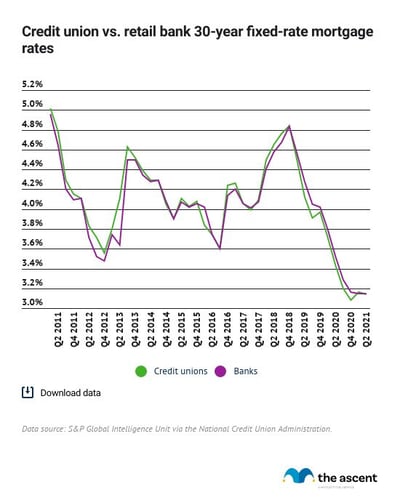
| Quarter | Average 30-year fixed-rate mortgage interest rate, credit unions | Average 30-year fixed-rate mortgage interest rate, banks |
|---|---|---|
| Q2 2021 | 3.14% | 3.15% |
| Q1 2021 | 3.16% | 3.15% |
| Q4 2020 | 3.08% | 3.16% |
| Q3 2020 | 3.20% | 3.29% |
Credit union vs. retail bank 15-year fixed-rate mortgage rates
In the second quarter of 2021, the national average 15-year fixed-rate mortgage interest rate provided by credit unions was 2.59%. The national average rate that banks provided was 2.66%.
In 2020–21, credit unions provided lower interest rates than banks for 15-year fixed-rate mortgages in all four quarters.
Over the past decade, credit unions have been more likely to provide better rates than credit unions for 15-year fixed-rate mortgages -- they did so in 23 out of the last 40 quarters.
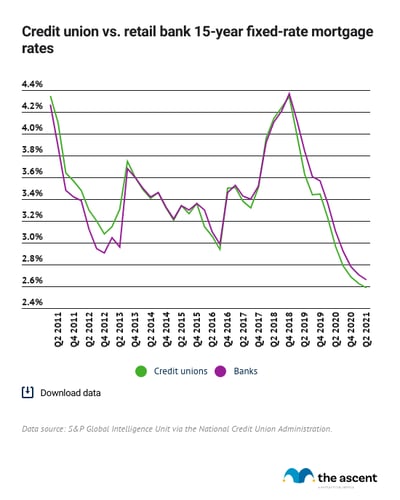
| Quarter | Average 15-year fixed-rate mortgage interest rate, credit unions | Average 15-year fixed-rate mortgage interest rate, banks |
|---|---|---|
| Q2 2021 | 2.59% | 2.66% |
| Q1 2021 | 2.63% | 2.71% |
| Q4 2020 | 2.69% | 2.78% |
| Q3 2020 | 2.79% | 2.92% |
Credit union vs. retail bank 5/1-year adjustable-rate mortgage rates
In the second quarter of 2021, the national average 5/1-year adjustable-rate mortgage interest rate provided by credit unions was 2.98%. The national average rate that banks provided was 3.56%.
Over the past year, credit unions provided lower interest rates than banks for 5/1-year adjustable-rate mortgages in all four quarters.
Over the past decade, credit unions have been more likely to provide better rates than credit unions for 5/1-year adjustable-rate mortgages -- they did so in 32 out of the last 40 quarters.
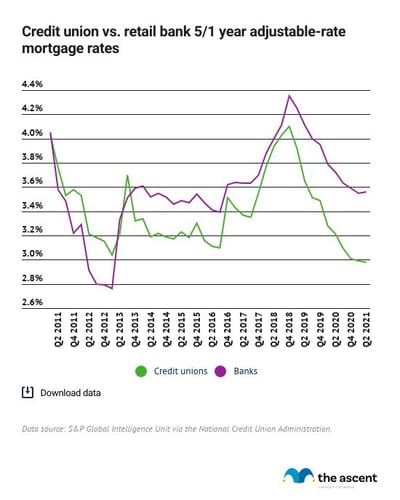
Credit union vs. retail bank auto loan interest rates
On average, credit unions consistently provide better auto loan rates than banks, often by over 1.5 percentage points.
Although 1.5% doesn’t seem like a significant margin and may not result in an astronomically lower monthly payment, over four or five years that difference can amount to decent savings.
Credit union vs. retail bank 60-month new car loan rates
In the second quarter of 2021, the national average interest rate on a 60-month new car loan provided by credit unions was 2.87%. The national average rate that banks provided was 4.78%.
Over the past year (2020–21), credit unions provided lower interest rates than banks for 60-month new car loans in all four quarters. On average, credit unions provided rates 1.8 percentage points lower than banks.
Over the past decade, credit unions provided lower rates for 60-month new car loans in every quarter.
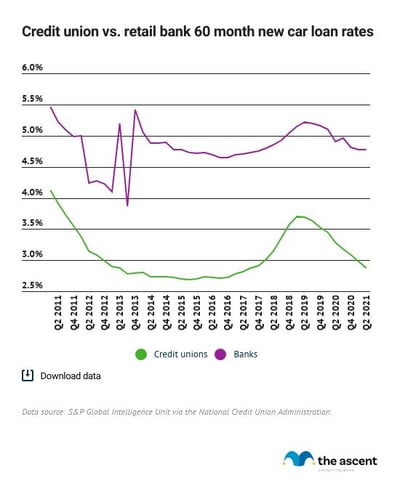
| Quarter | Average 60-month new car loan rate, credit unions | Average 60-month new car loan rate, banks |
|---|---|---|
| Q2 2021 | 2.87% | 4.78% |
| Q1 2021 | 2.98% | 4.77% |
| Q4 2020 | 3.09% | 4.81% |
| Q3 2020 | 3.18% | 4.96% |
Credit union vs. retail bank 48-month new car loan rates
In the second quarter of 2021, the national average interest rate on a 48-month new car loan provided by credit unions was 2.76%. The national average rate that banks provided was 4.68%.
Over the past year, credit unions provided lower interest rates than banks for 48-month new car loans in all four quarters. On average, credit unions provided rates 1.81 percentage points lower than banks.
Over the past decade, credit unions provided lower rates for 48-month new car loans in every quarter.
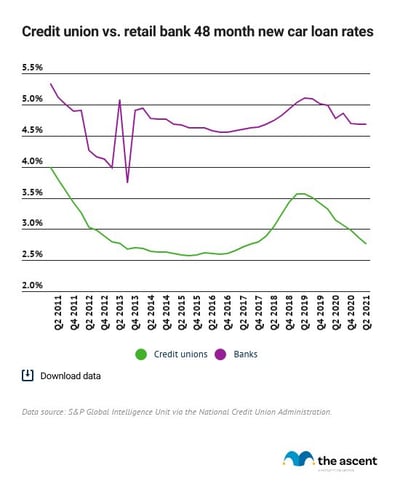
| Quarter | Average 48-month new car loan rate, credit unions | Average 48-month new car loan rate, banks |
|---|---|---|
| Q2 2021 | 2.76% | 4.68% |
| Q1 2021 | 2.86% | 4.68% |
| Q4 2020 | 2.98% | 4.70% |
| Q3 2020 | 3.06% | 4.86% |
Credit union vs. retail bank 48-month used car loan rates
In the second quarter of 2021, the national average interest rate on a 48-month used car loan provided by credit unions was 2.91%. The national average rate that banks provided was 5.13%.
Over the past year, credit unions provided lower interest rates than banks for 48-month used car loans in all four quarters. On average, credit unions provided rates 2.1 percentage points lower than banks.
Over the past decade, credit unions provided lower rates for 48-month used car loans in every quarter.
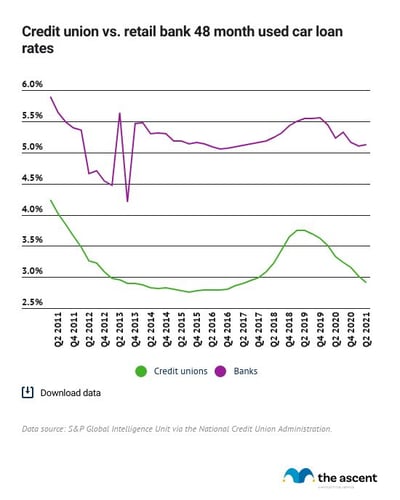
| Quarter | Average 48-month used car loan rate, credit unions | Average 48-month used car loan rate, banks |
|---|---|---|
| Q2 2021 | 2.91% | 5.13% |
| Q1 2021 | 3.02% | 5.10% |
| Q4 2020 | 3.16% | 5.16% |
| Q3 2020 | 3.24% | 5.32% |
Credit union vs. retail bank 36-month used car loan rates
In the second quarter of 2021, the national average interest rate on a 36-month used car loan provided by credit unions was 2.80%. The national average rate that banks provided was 5.08%.
Over the past year, credit unions provided lower interest rates than banks for 36-month used car loans in all four quarters. On average, credit unions provided rates 2.17 percentage points lower than banks.
Over the past decade, credit unions provided lower rates for 36-month used car loans in every quarter.
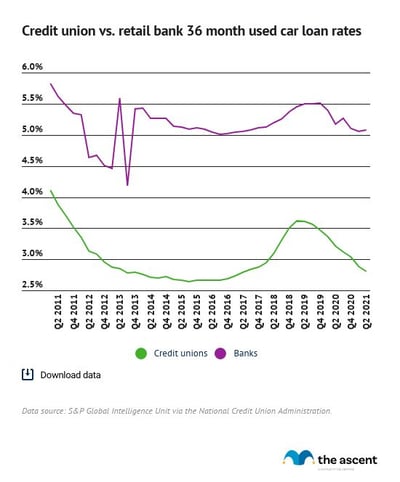
| Quarter | Average 36-month used car loan rate, credit unions | Average 36-month used car loan rate, banks |
|---|---|---|
| Q2 2021 | 2.80% | 5.08% |
| Q1 2021 | 2.89% | 5.06% |
| Q4 2020 | 3.04% | 5.10% |
| Q3 2020 | 3.12% | 5.27% |
Credit union vs. retail bank five-year certificate of deposit (CD) interest rates
The best certificates of deposits provide a higher, fixed, annual percent yield (APY) than checking accounts and most savings accounts -- with a couple catches. Withdrawing money before the end of a CD term results in a penalty and interest earned on CDs are taxable even if you haven’t spent those gains.
In the second quarter of 2021, the national average interest rate on a five-year CD provided by credit unions was 0.74%. The national average rate that banks provided was 0.61%.
Over the past year (2020–21), credit unions provided higher interest rates than banks for five-year CDs over all four quarters. Over the past four quarters, credit unions provided five-year CDs with interest rates 0.33 percentage points higher than those provided by banks.
Over the past decade, credit unions provided higher rates for five-year CDs in every quarter.
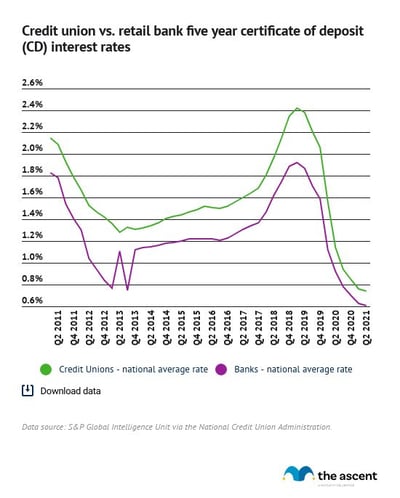
| Quarter | Average five-year certificate of deposit (CD) interest rate, credit unions | Average five-year certificate of deposit (CD) interest rate, banks |
|---|---|---|
| Q2 2021 | 0.74% | 0.61% |
| Q1 2021 | 0.76% | 0.63% |
| Q4 2020 | 0.85% | 0.70% |
| Q3 2020 | 0.94% | 0.78% |
Credit union vs. retail bank savings account interest rates
In the second quarter of 2021, the national average APY for savings accounts provided by credit unions was 0.09%. That national average rate that banks provided was the same.
Over the past year, credit unions have offered equal or better savings account rates than banks.
Over the past decade, credit unions provided better rates than banks in 24 out of 40 quarters.
That said, the best savings accounts come from institutions that provide rates well above the national average.
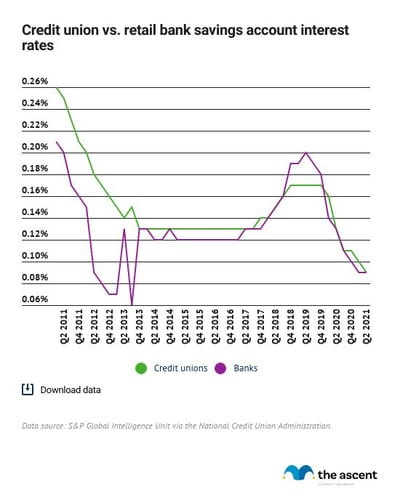
| Quarter | Average savings account interest rate, credit unions | Average savings account interest rate, banks |
|---|---|---|
| Q2 2021 | 0.09% | 0.09% |
| Q1 2021 | 0.10% | 0.09% |
| Q4 2020 | 0.11% | 0.10% |
| Q3 2020 | 0.11% | 0.11% |
Credit union vs. retail bank checking account interest rates
In the second quarter of 2021, the national average percentage yield for checking accounts provided by credit unions was 0.08%. The national average rate provided by banks was 0.07%.
Over the past year, credit unions offered equal rates in three quarters and a better rate in one quarter, on average.
Over the past decade, credit unions provided better rates on checking accounts than banks in 25 out of 40 quarters.
As with savings accounts, the best checking accounts are offered by institutions that provide rates about the national average or other perks like cash back or other rewards.
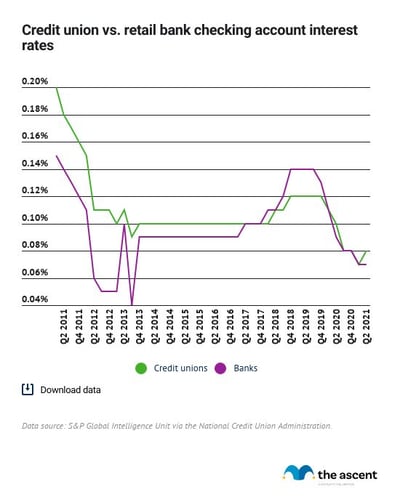
| Quarter | Average checking account interest rate, credit unions | Average checking account interest rate, banks |
|---|---|---|
| Q2 2021 | 0.08% | 0.07% |
| Q1 2021 | 0.07% | 0.07% |
| Q4 2020 | 0.08% | 0.08% |
| Q3 2020 | 0.08% | 0.08% |
Credit union vs. retail bank home equity line of credit (HELOC) rates
In the second quarter of 2021, the national average interest rate on a home equity line of credit (HELOC) provided by a credit union was 3.81%. The national average rate provided by banks was 4.1%.
Over the past year, credit unions provided better rates than banks in every quarter.
Over the past decade, credit unions provided better rates on HELOCs in all 40 quarters.
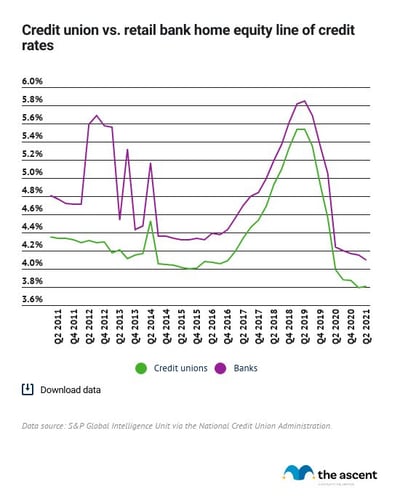
Who has better interest rates: credit unions or banks?
Based on recent data and data over the past decade, credit unions on average provide better interest rates than banks for most loans and deposits.
But deciding about which lender to turn to for a mortgage or auto loan, or where to set up checking and savings accounts, is more than just comparing the average rates offered by banks and credit unions across the country. And other factors like your credit score can influence whether or not you qualify for the best rate that a credit union or bank can offer.
While credit unions, on average, offer better interest rates than banks in many areas, banks often provide great perks. That’s why it’s important to shop around to find the bank or credit union that works best for your unique circumstances.
Sources
- S&P Global Intelligence Unit via the National Credit Union Administration (2021). "Credit Union and Bank Rates."
Our Research Expert
We're firm believers in the Golden Rule, which is why editorial opinions are ours alone and have not been previously reviewed, approved, or endorsed by included advertisers. The Ascent, a Motley Fool service, does not cover all offers on the market. The Ascent has a dedicated team of editors and analysts focused on personal finance, and they follow the same set of publishing standards and editorial integrity while maintaining professional separation from the analysts and editors on other Motley Fool brands. The Motley Fool has a Disclosure Policy. The Author and/or The Motley Fool may have an interest in companies mentioned.